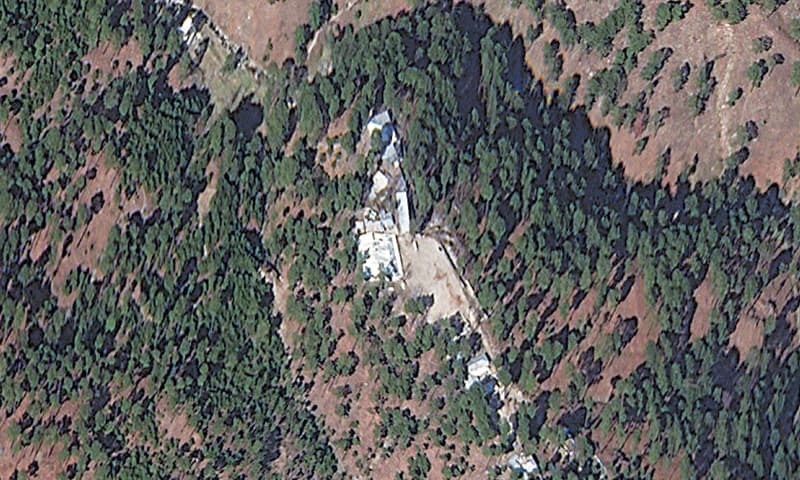
The “destroyed” JeM terror camp, circa March 4th, 6 days after it was “bombed.” Click to see full size image.
High-resolution satellite images revealed that the religious school run by Jaish-e-Mohammad (JeM) in northeastern Pakistan is still intact days after India claimed its warplanes had destroyed it, Reuters discovered.
The entire pretext behind India’s incursion into Pakistani airspace over the contest region of Kashmir was to bomb the terror training camp on February 26th. Which in itself was a response to an attack by the group on February 14th. JeM carried out a suicide bombing of a bus carrying Indian paramilitary police reserve officers, which killed 40.
Satellite images reviewed by @Reuters cast doubt on India airstrike claims https://t.co/LgMQuys3x6 via @ReutersTV pic.twitter.com/m2i9ADiyd2
— Reuters (@Reuters) March 6, 2019
The images produced by Planet Labs Inc, a San Francisco-based private satellite operator, show at least six buildings on the madrasa site on March 4, six days after the airstrike.
“Until now, no high-resolution satellite images were publicly available. But the images from Planet Labs, which show details as small as 72 cm (28 inches), offer a clearer look at the structures the Indian government said it attacked.
The image is virtually unchanged from an April 2018 satellite photo of the facility. There are no discernible holes in the roofs of buildings, no signs of scorching, blown-out walls, displaced trees around the madrasa or other signs of an aerial attack.”
The reveal casts even more doubt on Indian Prime Minister Narendra Modi’s claims that the February 26th air strike hit all intended targets at the madrasa site near Jaba village and the town of Balakot in Pakistan’s Khyber Pakhtunkhwa province.
No response to requests for comment was provided by the Indian foreign and defense ministers regarding what is shown on the satellite imagery.
Reuters also cited Jeffrey Lewis, director of the East Asia Nonproliferation Project at the Middlebury Institute of International Studies, who has 15 years’ experience in analyzing satellite images of weapons sites and systems. He confirmed that the satellite images show the structures in question.
“The high-resolution images don’t show any evidence of bomb damage,” he said.
Indian officials initially refused to say how many terrorists had allegedly been killed in the attack. Then claims of as many as 300 killed surfaced, while other officials said that the attack was simply a deterring, warning measure and aimed at killing none and achieved precisely that.
From the start Pakistan’s military claimed the Indian jets had merely dropped their bombs on a largely empty hillside amidst sustained Pakistani defense measures.
Major General Asif Ghafoor, spokesman for the Pakistani military, said, “There has been no damage to any infrastructure or human life as a result of Indian incursion.” He added further of a ground investigation of the site: “This has been vindicated by both domestic and international media after visiting the site.”
Following the airstrike on February 26th, an Indian MiG-21 shot down by Pakistani fighters and a pilot was captured. That pilot was later handed back to India in a “peace gesture.”
However, it appears that claims the entire situation was an attempt to politicize terror and be a sort of election campaign of Narendra Modi.
As ZeroHedge reported, “should India’s version of events ultimately be debunked in international press, it would likely seal Modi’s fate in the upcoming election, and could go down as among the most infamous false flags in the history of the Indian-Pakistan conflict.”
MORE ON THE TOPIC:




The great humiliation for India. And reaction from Pakistan was really astonishing
with outstanding bravery.
Indians did fuck all and were humiliated, the Pakistani took the high road and did not gloat at their amazing victory in the skies. Pakistan is a very tech savvy country and in this era of smart phones the kids on the ground who saw the dogfights filmed the action as Wing Commander Nuaman Ali Khan of MR-16 Black Panthers from Kamra chases an Indian SU-3O MKI at tree tops levels and then shooting it down over Attari on the Indian side of the border. Two Indian chutes are visible.
Pakistani JF-17 Thunder chasing and Indian SU30
https://www.youtube.com/watch?v=BsS87rIhGNs
I think that is what he said.
and they supposedly used high-tech fail proof israeli made bombs – what I always suspected, the squatters are good for nothing except stealing and murdering innocents and running a concentration camp a la treblinka with the prominent feature being ethnic cleansing to achieve the full DEPALESTINATION of the land they’ve stolen while killing any palestinian they can get a bead on. with impunity.
Those bombs seem to be able to hit Palestinian targets with ease. And burned out Syrian Pantsirs also show that when used well Israeli smart bombs can hit their target. I think you’re equating poor handling with poor gear. It doesn’t matter how good your gear is, if you have chimps using it you will get poor results. On paper the Indians have better aircraft and equipment then the Pakistanis. And yet the latter came out on top. And now they even failed to hit their target. That to me suggests the Indians have become complacent and only think in terms of getting ‘better gear’. Whereas the Pakistanis can only get Chinese junk, so they think in terms of using what they have better. Which IMHO is always a better strategy, regardless of the gear you can get.
Verner, Israeli bombs are in fact very high-tech, they are designed to kill civilians, ane have great success in doint this :)
Does this mean that Israel military hardware is just garbage ?
Yes, as seen in Syria